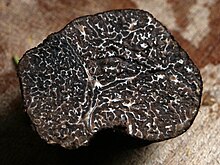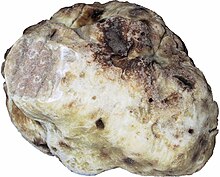Truffle
| Truffle | |
|---|---|

| |
| A basket of black truffles. | |
| Scientific classification | |
| Kingdom: | |
| Division: | |
| Subphylum: | |
| Class: | |
| Order: | |
| Family: | |
| Genus: | Tuber
|
Atruffleis thefruiting bodyof an undergroundmushroom.Its spores are dispersed byfungivores(animals that eat fungi). Almost all truffles are found in close association with trees (seemycorrhiza).
Truffles are used as a food additive in cooking. The truffles improve the flavour. There are hundreds of species of truffles that can be used, but the fruiting body of some (mostly in thegenusTuber) are highly prized. The 18th-century FrenchgastronomeBrillat-Savarincalled these truffles "the diamond of the kitchen". Edible truffles are expensive because they are held in high esteem inhaute cuisine.They are used in the cuisine of many countries in Europe and worldwide.
Types
[change|change source]Black truffle
[change|change source]
The "black truffle" or "black Périgord truffle"Tuber melanosporumis named after thePérigordregion inFranceand grows only withoak.Specimens can be found in late autumn and winter, reaching 7 cm in diameter and weighing up to 100 g.[1]Production is almost exclusively European, withFranceaccounting for 45%,Spain35%,Italy20%, and small amounts fromSlovenia,Croatiaand the Australian states of Tasmania and Western Australia (seebelow). In 1900, France produced around 1,000 metric tonnes (1,100short tons) ofTuber melanosporum.Production has considerably shrunk in the past century, and is now around 20 metric tonnes (22 short tons) per year, with peaks at 46 metric tonnes (50 short tons) in the best years. About 80% of the French production comes from southeast France. The largest truffle market in France (and probably also in the world) is atRicherenchesinVaucluse.The largest truffle market in southwest France is atLalbenqueinQuercy.These markets are busiest in the month of January, when the black truffles have their highest perfume. As of December 2009, black truffles were sold for about €1,000 per kilo in a farmer's market[2]and €3,940 per kilo in a retail saler.[3]
White truffle
[change|change source]
The "white truffle" orAlba madonnaorTuber magnatumcomes from theMontferratandLangheareas of thePiedmontregion in northernItalyand in the countryside around the city ofAlba.It is also found inCroatia,on theIstriapeninsula in theMotovunforest alongside Mirna river.[4]They grow with oak, hazel, poplar and beech trees, and fruit in autumn. They can reach 12 cm diameter and 500 g, though are usually much smaller. The flesh is pale cream or brown with white marbling.[1]Like the French black truffles, Italian white truffles are very highly esteemed (illustration, left). The white truffle market in Alba is busiest in the months of October and November, where a 1.6-pound white truffle sold to "The Cody" of southern California for $150,000 on November 8, 2009 during the 79thWhite Truffle Festival.In 2001, theTuber magnatumtruffles sold for between US$1,000 and $2,200 per pound;[5]as of December 2009 they were being sold at €10,200 per kilogram.[6]
Giancarlo Zigante and his dog Diana found one of the largest truffles in the world nearBuje,Croatia.The truffle weighed 1.31 kilograms (2.9 lb) and has entered theGuinness Book of Records.
The record price paid for a single white truffle was set in December 2007, whenMacaucasino ownerStanley Hopaid US$330,000 (£165,000) for a specimen weighing 1.5 kilograms (3.3 lb), discovered by Luciano Savini and his dog Rocco. One of the largest truffles found in decades, it was unearthed nearPisaand sold at an auction held simultaneously in Macau,Hong KongandFlorence.[7]This record was then matched on November 27, 2010 when Ho again paid US$330,000 for a pair of white truffles including one weighing nearly a kilogram.
Extraction
[change|change source]

Looking for truffles in open ground is almost always carried out with specially trainedpigs(hogs) or, more recently,dogs.TheLagotto Romagnolois the only dog breed recognized for sniffing out truffles (although virtually any breed could be trained for this purpose).[8]
| Truffle hog | Truffle dog |
|---|---|
| Keen sense of smell | Keen sense of smell |
| Innateability to sniff out truffles | Must be trained |
| Tendency to eat truffles | Easier to control |
The female pig's natural truffle-seeking, as well as her intent to eat the truffle, is due to a compound in the truffle. This compound is similar toandrostenol,the sexpheromoneofboarsaliva,to which thesowis keenly attracted.
InItaly,the use of the pig to hunt truffles is prohibited since 1985 due to damage caused by animals to truffle'smyceliaduring the digging that dropped the production rate of the area for some years.
Cultivation
[change|change source]Truffles can be cultivated, but it is not easy. The two world wars disrupted the growing of truffles in Europe, and changes in land use has reduced the available area. Truffles are now being cultivated in Australia and New Zealand.[9][10]
References
[change|change source]- ↑1.01.1Carluccio A (2003).The Complete Mushroom Book.Quadrille.ISBN1-84400-040-0.
- ↑Ladepeche.fr - Jean-Michel Fabre, "Lalbenque. 1 000 € le kg: la truffe de Noël au prix du diamant", 23/12/2009.
- ↑"Maison de la Truffe - TRUFFE FRAÎCHE NOIRE".Archived fromthe originalon 2009-12-28.Retrieved2011-02-21.
- ↑"Gastro.croatia.hr".Archived fromthe originalon 2008-01-20.Retrieved2011-02-21.
- ↑"Page moved | National Restaurant Association".Archived fromthe originalon 2011-07-18.Retrieved2011-02-21.
- ↑"Maison de ça Truffe - TRUFFE FRAÎCHE BLANCHE (in French)".Archived fromthe originalon 2009-12-28.Retrieved2011-02-21.
- ↑"Giant truffle sets record price".BBC News.2007-12-02.Retrieved2007-12-02.
- ↑Krista Simmons (28 August 2009)."On the hunt for truffles in Western Australia".Los Angeles Times.Retrieved2009-08-31.
Traditionally, truffle hunters — the Aussies call them "punters" — have used pigs to track their prey. More recently, punters have started using dogs, which, unlike pigs, will settle for a biscuit instead of chowing down on the truffle.
- ↑Zambonelli, Alessandra; Bonito, Gregory M, eds. (2013).Edible Ectomycorrhizal Mushrooms: Current Knowledge and Future Prospects.Germany: Springer. p. 193.ISBN978-3-64233822-9.Retrieved22 Mar2014.
- ↑"Truffles in New Zealand".Southern_truffles.co.nz. Archived fromthe originalon 2013-05-04.Retrieved2012-07-19.
- Trappe, Matt; Evans, Frank; Trappe, James M. (2007).Field Guide to North American Truffles: hunting, identifying, and enjoying the World's most prized fungi.Natural History Series. Ten Speed Press.ISBN9781580088626.
- Brillat-Savarin, Jean Anthelme(1838) [1825].Physiologie du goût.Paris: Charpentier. pp. 109–118.English translationArchived2008-07-06 at theWayback Machine
Other websites
[change|change source]- breeding, pictures,culinary recipes "Archived2016-03-05 at theWayback MachineSpecies of Truffles, "hunting" techniques [en] & [ro]
- Website of the North American Truffling Society
- "In the throes of truffle fever"by Tyrone Beason,Seattle Times,January 4, 2007
- Storage methods, preparations, and recipes
- Sorting truffle names
- "White Gold"[permanent dead link]by Fleur Kinson – the experience of a white truffle hunt and auction
